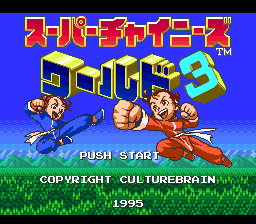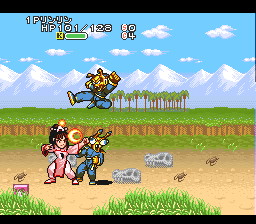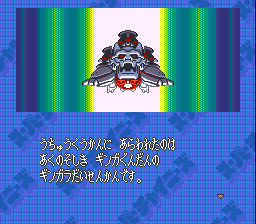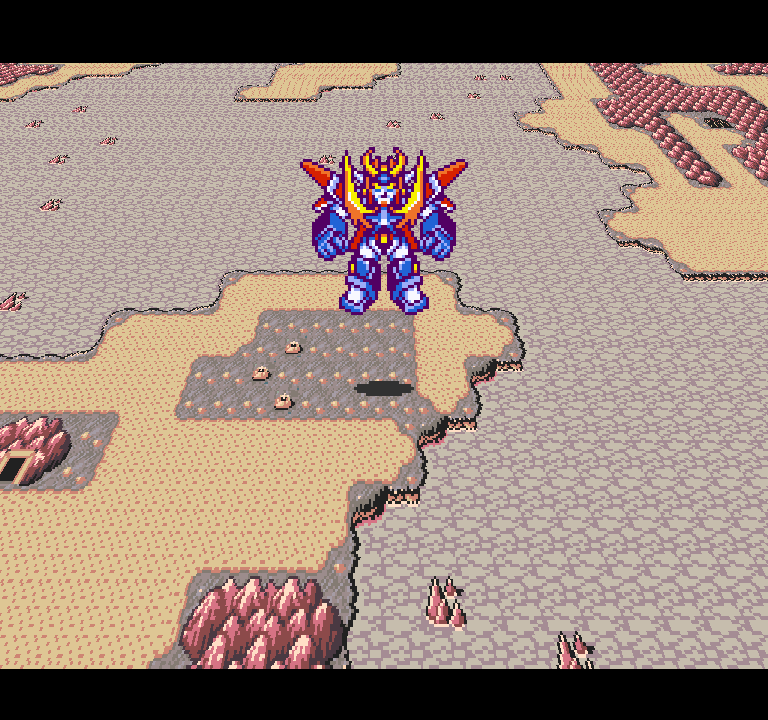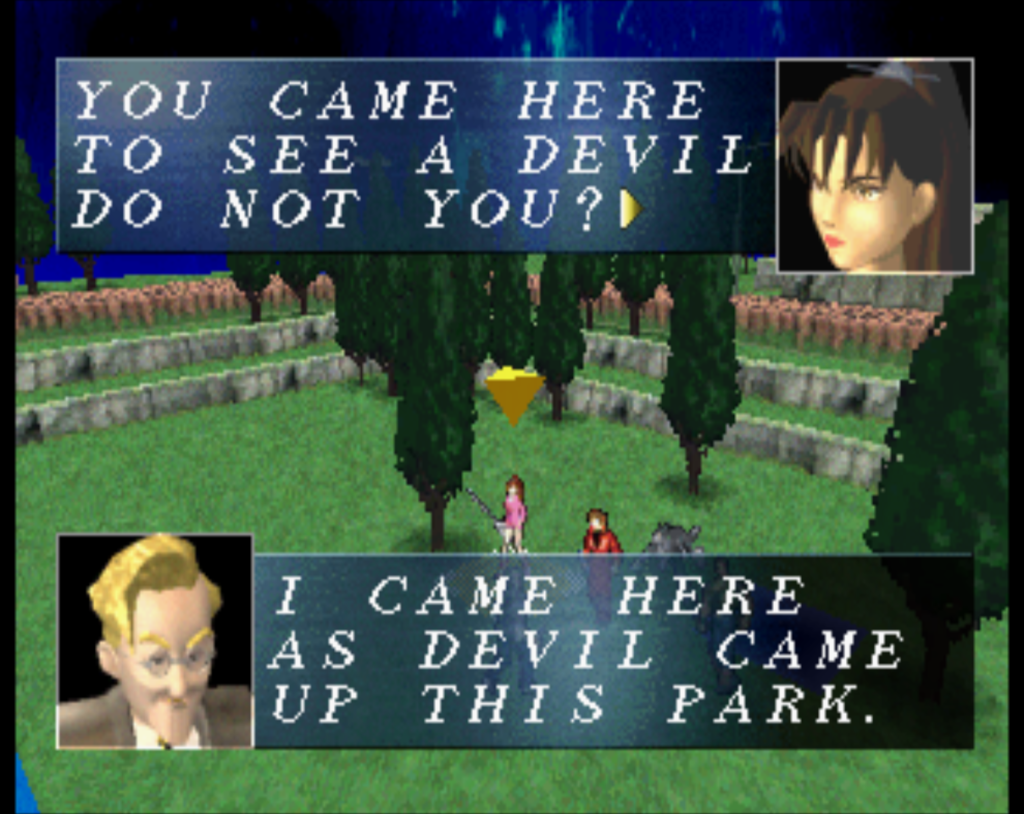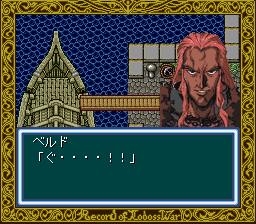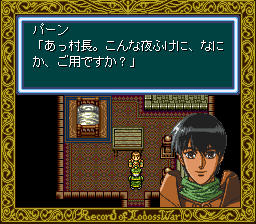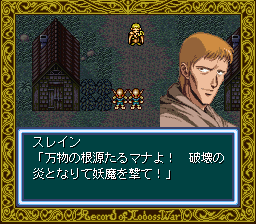Seiya Monogatari: AnEarth Fantasy Stories (聖夜物語), released 12/22/1995, developed by Mediaworks, published by Hudson

This is my second to last PC Engine game. It was released late in the system’s lifecycle, and was intended to be the first game in a trilogy. Although this game was re-released for the Sega Saturn, no more games were ever made. I had heard this game had a good reputation, and having completed the game I think the reputation is well deserved — I would put it in the top 5 games I’ve played for the SFC/PCE side of this blog.
The title means “Holy Night Story” — I’ve seen it translated as “Christmas Eve Story”; while it’s true that the word 聖夜 does mean “Christmas Eve”, this story has no explicitly Christian content, it’s more evocative of certain Christian ideas. The re-release dropped the “seiya monogatari” part.
The opening scene has no text, which is a shame because the characters are only introduced in the instruction manual (I later found the explanation on a blog) — I think everything in the manual is covered at some point in the story but it’s easier if you have the information off the bat.

This is Lena — in order to protect the savior Lazarus’ soul, it was transported into her womb and she gave birth to the main character. I accidentally named him Talis instead of Kurisu. The opening also shows Adis, the reincarnation of the magician Kyurientis, as well as Pope Velmessa, a child who is at the head of the Altnash Church and the new Holy Ishmelia Empire. He has declared himself to be the reincarnation of Lazarus.

As we move to the start of the game, a woman drops the child at a church. Three different people or groups walk back. By hitting the button to cry, you can get the attention of any of the groups, or if you don’t press anything, Sister Maria from the church will take the baby in. This determines what character type the main character will be, and also affects the story to a certain extent — the beginning is different for each path and whichever class you are, the corresponding PC will not join you. I went with the old man, which makes Talis a magician.
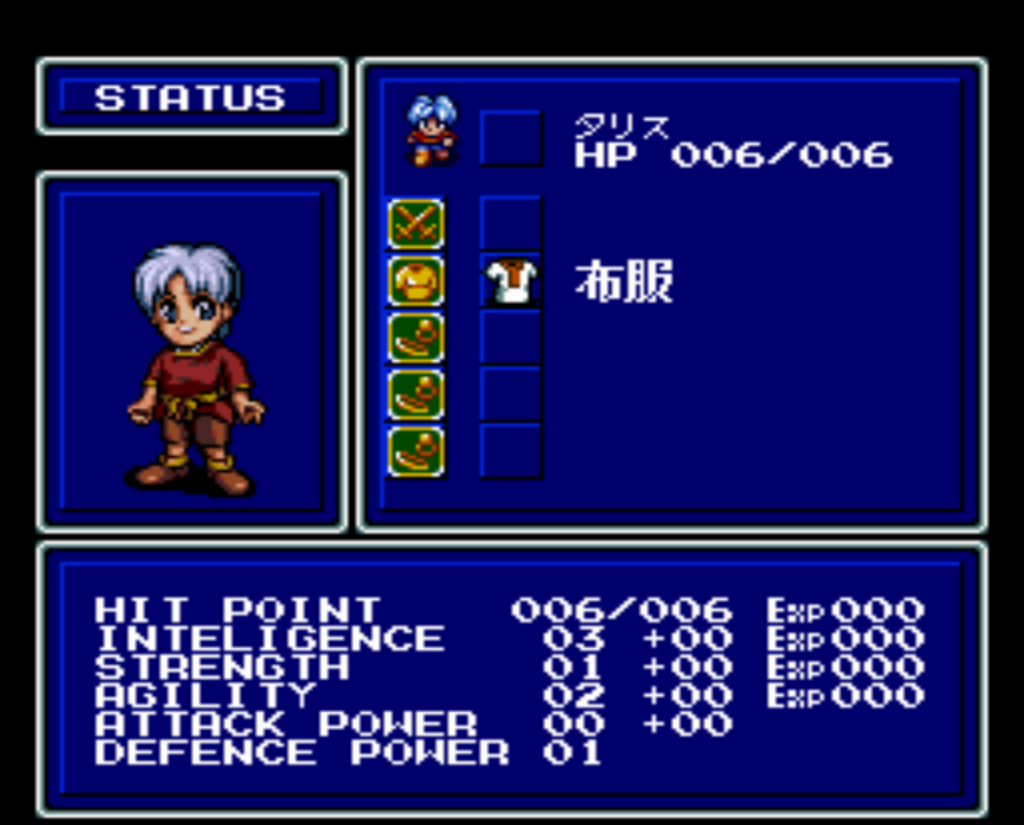
The graphics are a lot better than most other PC Engine games even from this late era. As you can see in the image above, this game doesn’t work off experience levels. Rather, what you do in battle gives you EXP in a number of different areas, and that will eventually raise stats. I wasn’t entirely sure what all the experience areas did, and I wish the interface would tell you when one of the stats levels up.
The first part of the game covers Talis at 5, 10, and 15 years old. Gregory, the old man, is a magician of some kind. He has a secret lab where Talis finds an object of some sort that makes a light come out; Lena’s voice appears and tells us we are the only hope of the world, to stop the Beast of Destruction. These objects serve as the save points throughout the game.
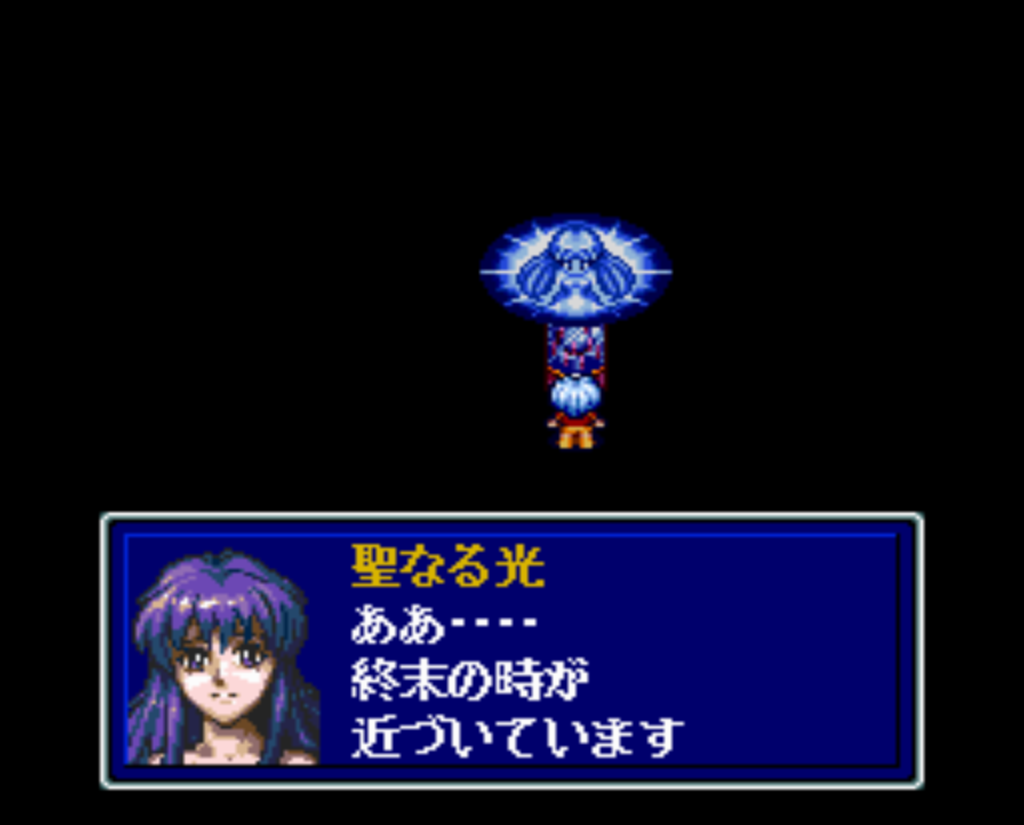
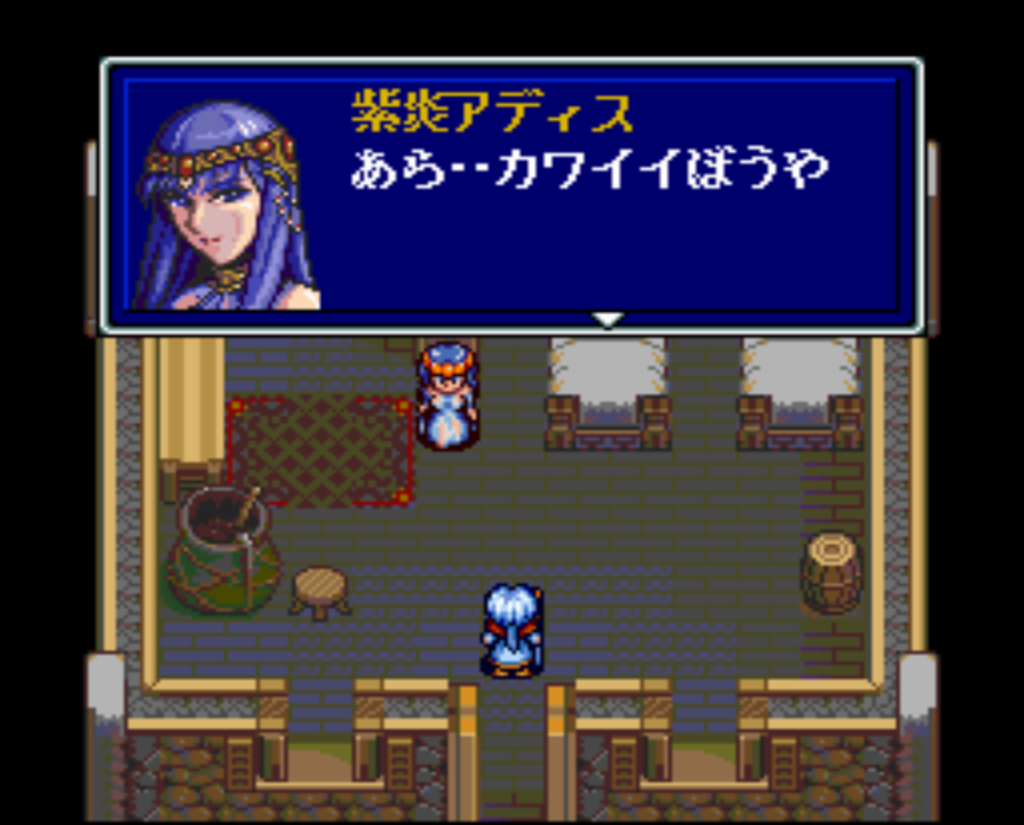
When Talis is 15, people from the Altnash Church show up and take over the building, preventing us from entering.
Adis shows up, wanting to take away (or possibly kill) Talis. Gregory recognizes her as the reincarnation of his teacher, and traps her in his secret lab by turning himself to stone so that Adis can’t get the unlock word out of him. She says she’ll be able to do it eventually, but this gives Talis time to escape.
Gregory leaves Talis with a magic scroll to use the Thunder spell, and some Holix. Spells in the game require you to have acquired the scroll for the spell, and then have the necessary Holix to cast them. There are 14 different Holix varieties. You can acquire the one-use Holix from various places, but you can also find Eternal Holix which allow you to use that Holix permanently. The only screenshot I have of the screen is from the end of the game:
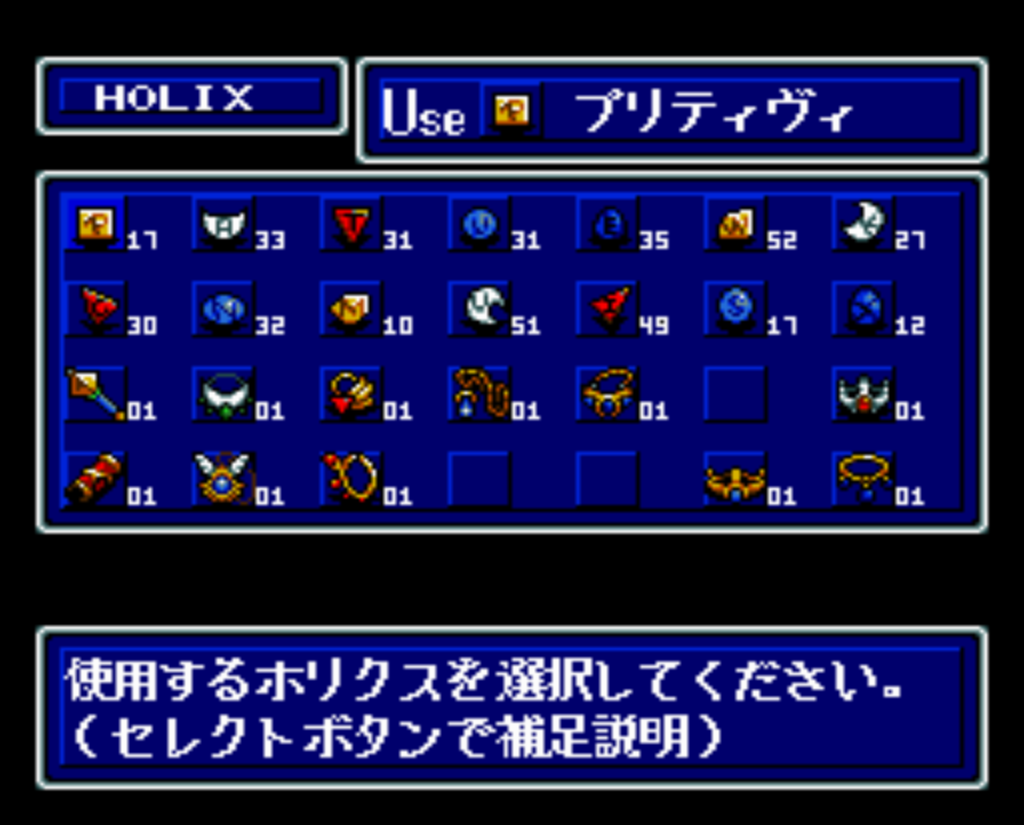
I assume there is one permanent holix for each type; I know I missed one from doing an event in the wrong order, but the other 2 I never found. A lot of them are pretty well hidden and I would not have found a few of them if I hadn’t gotten some information from a blog.
Gregory also leaves behind the broken Vayu Sword which was left with Talis as a baby (I think this is how he gets it in this version of the story), and tells Talis to go to the capital Rostal where he can learn more about magic. So we exit to the world map.

Here you just choose a place to go, but you can only go to places that you know about (even if they are spelled out on the map, you can’t always go there right away). At first the only place you can go is Jupito. There Talis runs into an old woman swordsman, Olga. She’ll be our warrior PC for the game (an interesting choice). But for now she’s in a hurry to go to the Urikuri village in Ulantaya forest — they’re being attacked by bees.
I follower her there myself, and we get the first combat, saving one of the Urikuri from some Macbees. What is interesting about this game is that the encounters are neither random or even symbol encounters, but pre-set fights. It feels like playing a table-top RPG where the game master has decided on specific encounters for you to fight. There are a few encounters that will respawn but for the most part you can only do the pre-set fights, so there’s no grinding.
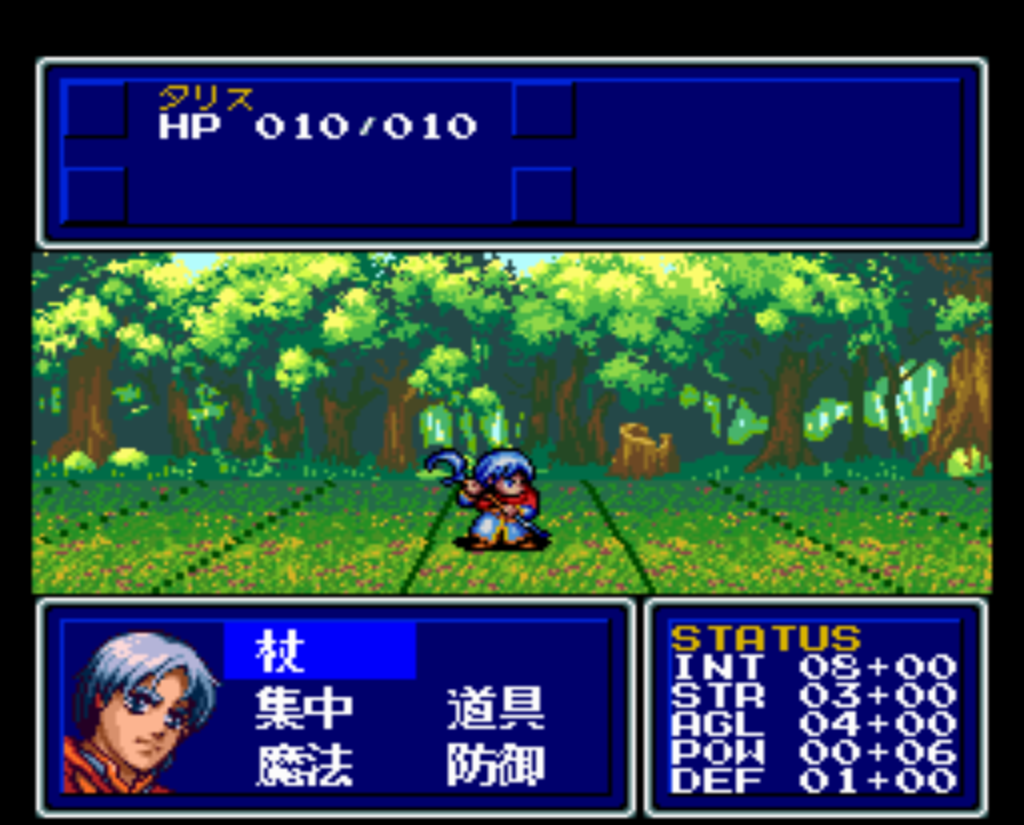
The battle is on a speed-based turn system. In addition to item and defense, Talis can “concentrate”, increasing the power of the next spell. He can cast spells, or use his staff to attack. The staff is a long-distance attack, which is nice when we get other companions because then Talis doesn’t have to expose himself as much to the enemies. The system has a sort of distance/range element, but moving up to attack the enemy doesn’t take any extra time or turns.
I didn’t know that the staff was a distance attack so I used two Lightning spells to take down the bees.

The forest has Holix scattered around it, though.
The fights do not give money. All the money you get in the game is from selling gems you find, or selling extra equipment. This makes money a pretty limited resource but I thought it worked well — I never felt like the money was so restricted that it was unfair or annoying, but I did feel like I had to consider every purchase. Near the end of the game a way did open up to make extra money, and I think there is one earlier in the game that I didn’t make use of.

The grateful Urikuri shows us to his village, where Talis is asked to defeat the Macbees that have taken residence in an old tree.

Olga also joins up. She is able to do some kind of jumping attack which I think works better against flying units, and also an attack that can do damage to multiple enemies as long as they’re clustered up.

The battles in this initial part are not especially difficult; many of the enemies can’t hurt Olga. They can poison which is annoying because I had to leave the forest to rest, but I found out later that you can get poison healing herbs from the forest as well. The boss is a mother bee or some kind of mutant insect. Once the Urikuri are saved, Olga decides to accompany Talis — she seems to have some grudge against the Altnash Church as well.
Our next stop is in Marah, where we hope to get a ship to take us to the capital. Unfortunately the ships won’t come to port because of trouble in the town — there are bugs that have taken over the sewers (lots of bugs in this game). Also in the sewers we get our next companion, Vestril the priest.

In addition to magic, he can “preach” which will lower the attack of a human or other enemy that can understand speech, and will damage or outright kill an undead enemy. (One odd thing about the battles is that people flash red when they are near death, but they start flashing red as soon as the attack animation starts, before they get hit). I never got the point of the “thrust” attack (his second choice); any time I tried to use it the enemy blocked the attack.
Because there are fewer encounters, a lot of the dungeons involve puzzles — flipping switches and such. There is also an obelisk in the dungeon that tells us to return with Search magic to find a legendary sword.
The boss of the sewers is a weird bug woman, but with Vestril’s healing it’s not too bad. He also brings with him a few extra spells and a lot of Holix, and also the main character can use some of the new spells. But the spells are divided into different types, and the spellcasting characters have levels associated with each type. So Vestril is a lot better at healing than Talis is.
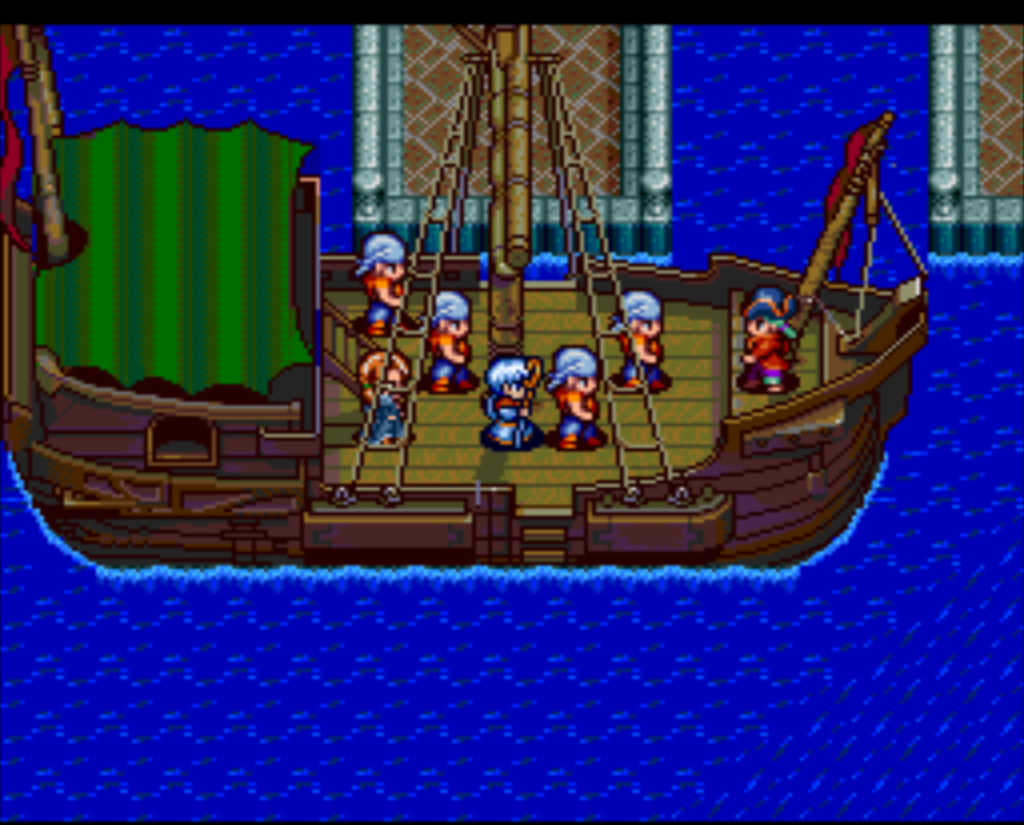
Now having cleared the bugs, ships can return to the area, but the only one we’re able to get a ride on is a pirate ship. Vestril decides to join us to recover a statue that he thinks the pirates have, and so we’re off to their island lair.
This is where I will stop — I think I will take 2 more posts to cover this. As a last note, the music in this game is quite good. Here’s a link to a playlist, and one of the songs I think is particularly good:
Good use of counterpoint, which is not so common in video game BGM.
Expect part 2 in the middle of the week some time.
